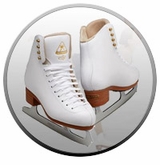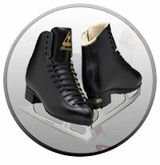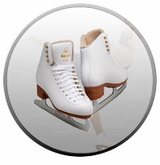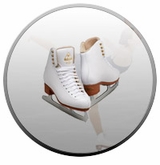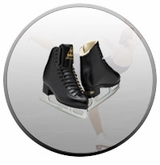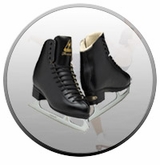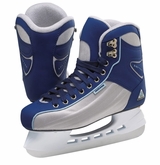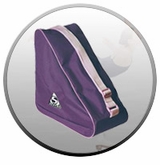Ice Skating Tips
If you are learning to ice skate, we offer several ice skating tips to help you along. We will start with what we consider to be two of the most important ice skating tips; learning how to fall, and how to stop - we will begin with falling. Please see our How to Ice Skate page for additional ice skating tips that can help you learn how to begin skating forwards and backwards.
Ice Skating Tips: How to Fall
Falling down is the single biggest risk for ice skaters. For this reason, one of the most valuable ice skating tips for any skater is learn how to minimize the risk of injury when falling. For beginning ice skaters, falling is inevitable; for experienced ice skaters, falling is a constant and real possibility. The goal for every ice skater when falling should be to avoid injuries and get back up quickly. If you are a beginner or concerned about falling, it is a good idea to wear ice skating skate protective gear (helmet, wrist, elbow, knee and possibly hip and tailbone pads).
The following represents our top 10 ice skating tips when it comes to learning how to safely fall. 1. Try to be relaxed when you fall; a limp body is far less likely to get injured than a stiff body. 2. If falling forward, keep your chin up. 3. If falling backwards, tuck in your chin – this, along with number two, will help you keep from hitting your head on the ice. 4. Try to prevent the wrists, elbows, hips and knees from hitting the ice first. 5. Always wear gloves when practicing falls. 6. Always try to land on your bottom first (when possible). 7. For extra protection, wear protective equipment as mentioned above. 8. When you do fall, pull your hands in to protect them from getting run over by other ice skaters. 9. To get up from a fall; move to your hands and knees, place one skate under you, and put the other skate under you as soon as practical, and lift yourself up. 10. When you fall, get up quickly from off the ice.
Practice Falling From a Standstill Position
1. Stand still on the ice. 2. Bend forward with your hands in front. 3. Extend your hands toward the ice, break the fall with your hands, and straighten the knees before they hit the ice (we recommend you use wrist guards at the very least when practicing falling). 4. Keep your head and chin up to prevent your head from hitting the ice. 5. Move quickly to your hands and knees. 6. Put one skate under you at a time and carefully extend your knees as you lift yourself up. 7. Practice these steps several times.
There are a number of potential ice skating tips to help you practice falling. These ice skating tips range from practicing while standing still, to practicing while ice skating forward, and practicing while ice skating backwards. For more ice skating tips, we strongly encourage ice skaters seek professional guidance from a certified ice skating instructor. When it comes to practicing falling, seeking professional guidance is probably our most important ice skating tip.
Lastly, it is worth noting that if you are skating outside, the second biggest ice skating risk is falling through the ice while skating on ponds, lakes, etc. Always make sure the ice is thick enough to support your weight; if in doubt skate elsewhere. It is also good to scope out the surface for any other obstacles that may be in the way. Finally, always skate with a partner – your safety may depend on it.
Ice Skating Tip: How to Stop
One of the first ice skating tips every skater should consider is to learn how to stop. There are a number of different ways to stop while ice skating, but here we will discuss three – the T-Stop, the Snowplow-Stop and the Hockey-Stop.
T-Stop
The T-Stop is probably the best stopping technique for beginning ice skaters to learn. The T-Stop is performed with the skates forming a t-position as the name implies. To execute a t-stop, you should: 1. Begin skating slowly in a forward direction. 2. Turn one skate at a 45 degree angle and drag it behind the other skate. 3. Pull the skate that is being dragged into the instep of the lead skate. 4. Shoulders should remain straight and forward in the skating direction. 5. Arms should be out to the side. 6. Lean back slightly and shift the body weight to the rear skate that is being dragged.
Snowplow Stop
The snowplow stop is another stop that is great for beginner ice skaters to learn. The snowplow stop got its name because of the ice shavings that buildup in front of the blade, resembles the snow that builds up in front of a snowplow. The snowplow stop is performed with the skates forming a pigeon-toed position. To execute a snowplow stop: 1. Begin skating slowly in a forward direction. 2. Arms straight out to the side. 3. Bend the knees, lean back slightly and push the skates apart. 4. As the skates are pushed apart, the feet should begin to form a pigeon-toed position. 5. The inside blades are used to shave the ice.
Hockey-stop
The hockey-stop is an important stop, and one that every ice skater should learn. The hockey-stop will bring skaters to an abrupt stop, even when skating relatively fast. The hockey-stop got its name because it is a stopping technique often used by hockey players. The hockey-stop is performed by turning both skates in the same direction, parallel to the direction skating. Ice skaters should learn the hockey-stop in both directions. To execute a hockey-stop: 1. Begin skating at a moderate speed in a forward direction. 2. Arms straight out to the side, skates should be slightly apart, knees bent. 3. Simultaneously, twist the shoulders in one direction and the feet in the opposite direction. 4. The lead skate will shave the ice on an outside edge, the trailing foot will shave the ice on an inside edge. 5. The hips and skates are facing to the side, the head, chest and stomach should be facing the skating direction.
Ice Skating Tip: How to Stop while Skating Backwards
There are multiple ice skating tips to help you stop while ice skating backwards. If you are skating with figure skates you can lift the heel of one of the skates and dig the toe-pick into the ice. This will not instantly stop forward (in this case backward) progress, but it will slow you down to an eventual stop. While skating on any ice skates you can use the backward Snowplow stop, and the backward T-stop; we address both below.
Backward Snowplow-stop
1. Bend both knees. 2. Turn the toe of one or both of the ice skates out (dragging it on an inside edge). 3. The inside edge of the skate(s) will eventually help bring you to a stop.
Backward T-stop
1. As you are skating backwards: 2. Bend the skating leg and lean forward. 3. Extend one ice skate behind you and turn it at a 45 degree angle. 4. Place the free skate onto the ice on an inside edge (set it down slowly to feel and adjust to the pressure accordingly).
A final ice skating tip to help you to stop while skating backwards is to execute a backward turn, and stop in the now forward direction by using the forward T-Stop, Snowplow-stop or the Hockey-stop.
|
Skate Equipment >
Ice Skating Equip
Ice Skating Info
.
